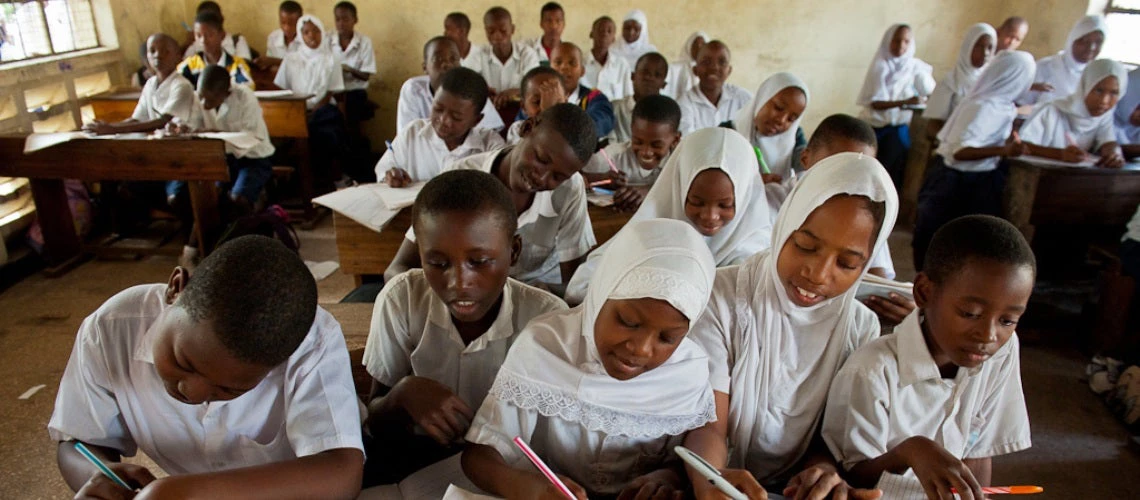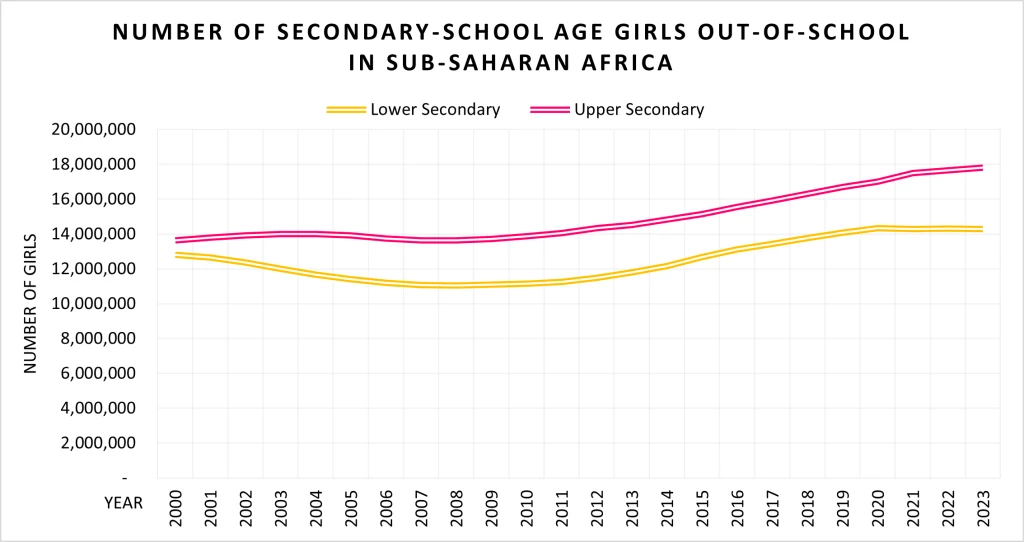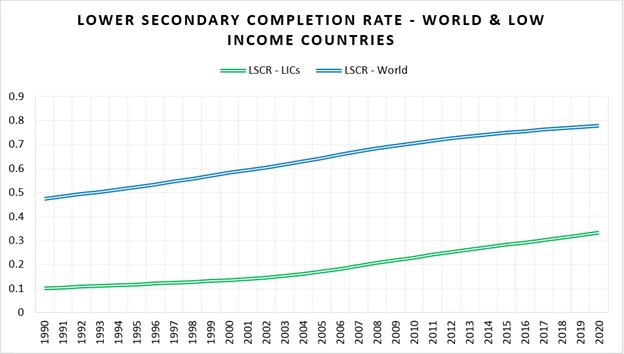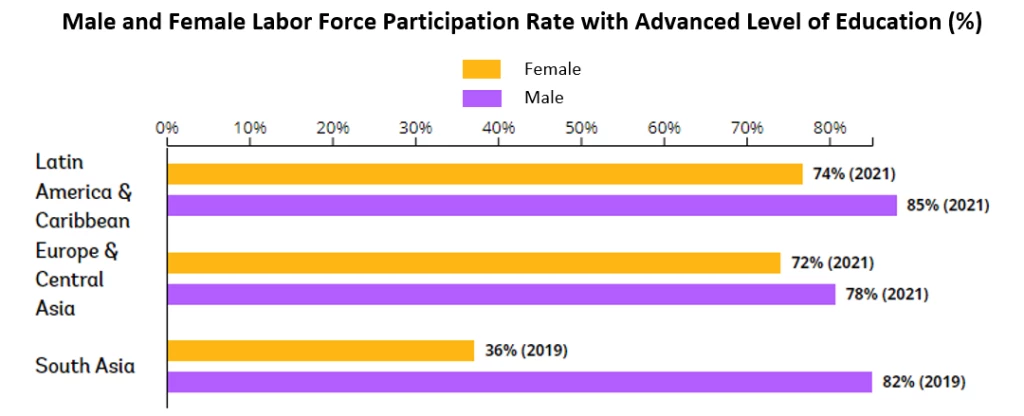 Girls’ enrollment and completion rates remain the highest at the primary education level, but this tapers down as they progress to higher levels of education. Copyright: Arne Hoel/World Bank.
Girls’ enrollment and completion rates remain the highest at the primary education level, but this tapers down as they progress to higher levels of education. Copyright: Arne Hoel/World Bank.
Girls are getting educated at higher levels today than ever before. The primary school completion rate has reached 90% for girls, with gender parity achieved in most countries. Girls have higher levels of learning than boys across most contexts, according to results from global assessments such as PISA and TIMSS, as well as the World Bank’s learning poverty data from low- and middle- income countries. At a global level, these outcomes indicate that girls are faring well in education systems.
However, the picture is much more complex, particularly in low-income countries and contexts affected by fragility, conflict, and violence (FCV), and when they transition from education systems to the labor market. On International Women’s Day 2023, we reflect on where girls are facing the most challenges, and how we can better understand where the remaining challenges lie in education and labor market outcomes for women.
Where do girls face the most disparities in education outcomes?
While globally gaps have narrowed, in low-income countries, gender gaps in schooling are the largest. Girls’ enrollment in primary school in low-income countries is 78%, compared to the world average of 88%, and only 31% in secondary school, compared to the global average of 66%.
In FCV contexts, girls are more likely to be out of school and learning poor. Girls are 2.5 times more likely to be out of school than those in non-FCV contexts, and are 90% more likely to be out of secondary school than in non-FCV contexts. Learning outcomes in these countries are hard to measure as there are large data gaps, but for many FCV countries, learning poverty levels are extremely high: in Chad, Burundi, Niger, Yemen, and Afghanistan learning poverty is above 90% for all children, with less than 1% difference between boys and girls.
In Sub-Saharan Africa, there are more children now out of school than ever before. While other regions of the world are reducing their out-of-school numbers, new data shows that the number of girls out-of-school in Sub-Saharan Africa is now increasing.

Out of the 120 million girls out of school globally at all education levels, over two-thirds of them, 86 million, are in these country groups, which experience the most gender disparities in education.

What trends do we see as girls progress through the education system?
Much remains to be done to ensure that girls persist through all levels of education. Girls’ enrollment and completion rates remain the highest at the primary education level, but this tapers down as they progress to higher levels of education. Boys face similar challenges. The completion rate at the lower secondary education level for girls is 78% globally. This rate is even lower for FCV (44%), low-income (38%) and Sub-Saharan African (43%) countries. At the upper secondary level of education, the global completion rate for girls is 45%. In Sub-Saharan Africa, this rate is a dismal 25%.

After progressing from primary to lower secondary education, students usually choose between a traditional education or technical and vocational education (TVET) track. Enrollment for young women in TVET programs is low, and women are less likely to be enrolled in TVET programs than men in all regions of the world.
After completing lower and upper secondary education, students can either directly enter the workforce or continue to tertiary education. Tertiary enrollment rates for women vary significantly by region. While in some regions more women are enrolled than men, in Sub-Saharan Africa this rate is 9%, and for low-income countries, it is 7%, compared to 43% globally. This is particularly important to take into consideration when we examine that there is a large global skills gap, mismatch and shortage.
Women and the labor market: a persisting gap
On average, more educational attainment leads to better labor market outcomes and higher earnings. However, in general, these education gains are not translating into labor market gains for women. Globally, the female labor force participation rate is 47%, compared to 72% for males. The lowest rates of female labor force participation are in South Asia (25%) and the Middle East and North Africa (18%), driven in part by social norms around women’s workforce participation, marriage, household responsibilities and cultural expectations.
This data is even more important to examine in contexts of labor force participation rates per level of education attained. In South Asia, we see one of the lowest female labor force participation rates for those women who have obtained advanced degrees, at only 36%. The same rate for men who have completed advanced degrees is 82%. This trend is unfortunately similar in many places, and suggests that despite higher levels of education attainment, the stickiness of gender norms in certain contexts creates barriers that do not let women realize their potential in the labor market.

The unrealized potential of women
Investment in girls’ education has the potential to generate the highest returns of any investment, is one of the most effective ways to promote social and economic development, reduce poverty, and advance gender equality. There are still many countries where this potential has yet to be realized. In low-income countries, FCV contexts, and in Sub-Saharan Africa, gender disparities in schooling are still alarming, and more programs need to support girls’ schooling at the primary and secondary level of education. Globally, young women still face many barriers while transitioning to the labor market. Supporting women to transition from education to the labor market is crucial for gender equality and economic growth. By reducing these disparities in education and labor market outcomes, we can ensure girls and young women are given the tools to reach their full potential, and have an equal chance to contribute this potential to the world.
This blog is part of a series for International Women’s Day 2023 by the Education Global Practice. More on the World Bank’s Girls’ Education work can be found here.
The authors would like to thank Yi Ning Wong, Maria Eugenia Oviedo and Melissa Merchant for their contributions to this blog.



Join the Conversation